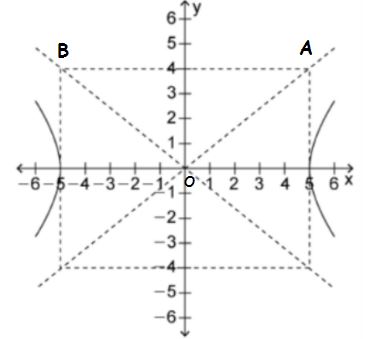Calculus: Early Transcendentals
8th Edition
ISBN:9781285741550
Author:James Stewart
Publisher:James Stewart
Chapter1: Functions And Models
Section: Chapter Questions
Problem 1RCC: (a) What is a function? What are its domain and range? (b) What is the graph of a function? (c) How...
Related questions
Question
100%
hown would I do this?
![**Question 10:** What's the standard form of the equation of the following hyperbola?
**Graph Description:**
The graph displays a hyperbola centered at the origin (0,0) on a coordinate plane. The x-axis and y-axis are marked with numerical values ranging from -6 to 6. The hyperbola opens horizontally along the x-axis. The asymptotes, which are dashed lines, extend diagonally and intersect at the origin. The asymptotes form a rectangle with vertices at (5, 4), (-5, 4), (-5, -4), and (5, -4).
**Answer Choices:**
- **A.** \(\frac{y^2}{25} - \frac{x^2}{16} = 1\)
- **B.** \(\frac{x^2}{25} - \frac{y^2}{16} = 1\)
- **C.** \(\frac{x^2}{16} - \frac{y^2}{25} = 1\)
- **D.** \(\frac{y^2}{16} - \frac{x^2}{25} = 1\)
**Explanation:**
To identify the correct standard form of the hyperbola's equation, observe that the hyperbola opens horizontally, indicating the \(x^2\) term comes first in the equation. The vertices are located at (5, 0) and (-5, 0), which suggests \(a^2 = 25\). The value of \(b^2\) can be determined by the rectangle formed by the asymptotes; here, \(b^2 = 16\). The appropriate equation will have the form:
\[ \frac{x^2}{a^2} - \frac{y^2}{b^2} = 1 \]
Therefore, the correct standard form of the hyperbola is:
- **C.** \(\frac{x^2}{16} - \frac{y^2}{25} = 1\)](/v2/_next/image?url=https%3A%2F%2Fcontent.bartleby.com%2Fqna-images%2Fquestion%2F9d2d3575-67e8-4858-8189-0d96dbc4ce7d%2F8a0f5289-afac-4717-ad50-2164252564b3%2Fngy3xde_processed.png&w=3840&q=75)
Transcribed Image Text:**Question 10:** What's the standard form of the equation of the following hyperbola?
**Graph Description:**
The graph displays a hyperbola centered at the origin (0,0) on a coordinate plane. The x-axis and y-axis are marked with numerical values ranging from -6 to 6. The hyperbola opens horizontally along the x-axis. The asymptotes, which are dashed lines, extend diagonally and intersect at the origin. The asymptotes form a rectangle with vertices at (5, 4), (-5, 4), (-5, -4), and (5, -4).
**Answer Choices:**
- **A.** \(\frac{y^2}{25} - \frac{x^2}{16} = 1\)
- **B.** \(\frac{x^2}{25} - \frac{y^2}{16} = 1\)
- **C.** \(\frac{x^2}{16} - \frac{y^2}{25} = 1\)
- **D.** \(\frac{y^2}{16} - \frac{x^2}{25} = 1\)
**Explanation:**
To identify the correct standard form of the hyperbola's equation, observe that the hyperbola opens horizontally, indicating the \(x^2\) term comes first in the equation. The vertices are located at (5, 0) and (-5, 0), which suggests \(a^2 = 25\). The value of \(b^2\) can be determined by the rectangle formed by the asymptotes; here, \(b^2 = 16\). The appropriate equation will have the form:
\[ \frac{x^2}{a^2} - \frac{y^2}{b^2} = 1 \]
Therefore, the correct standard form of the hyperbola is:
- **C.** \(\frac{x^2}{16} - \frac{y^2}{25} = 1\)
Expert Solution
Step 1

Step by step
Solved in 2 steps with 2 images

Recommended textbooks for you

Calculus: Early Transcendentals
Calculus
ISBN:
9781285741550
Author:
James Stewart
Publisher:
Cengage Learning

Thomas' Calculus (14th Edition)
Calculus
ISBN:
9780134438986
Author:
Joel R. Hass, Christopher E. Heil, Maurice D. Weir
Publisher:
PEARSON

Calculus: Early Transcendentals (3rd Edition)
Calculus
ISBN:
9780134763644
Author:
William L. Briggs, Lyle Cochran, Bernard Gillett, Eric Schulz
Publisher:
PEARSON

Calculus: Early Transcendentals
Calculus
ISBN:
9781285741550
Author:
James Stewart
Publisher:
Cengage Learning

Thomas' Calculus (14th Edition)
Calculus
ISBN:
9780134438986
Author:
Joel R. Hass, Christopher E. Heil, Maurice D. Weir
Publisher:
PEARSON

Calculus: Early Transcendentals (3rd Edition)
Calculus
ISBN:
9780134763644
Author:
William L. Briggs, Lyle Cochran, Bernard Gillett, Eric Schulz
Publisher:
PEARSON

Calculus: Early Transcendentals
Calculus
ISBN:
9781319050740
Author:
Jon Rogawski, Colin Adams, Robert Franzosa
Publisher:
W. H. Freeman


Calculus: Early Transcendental Functions
Calculus
ISBN:
9781337552516
Author:
Ron Larson, Bruce H. Edwards
Publisher:
Cengage Learning